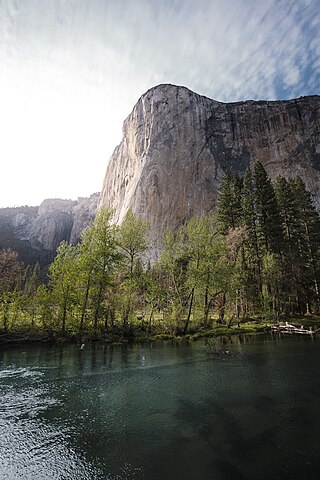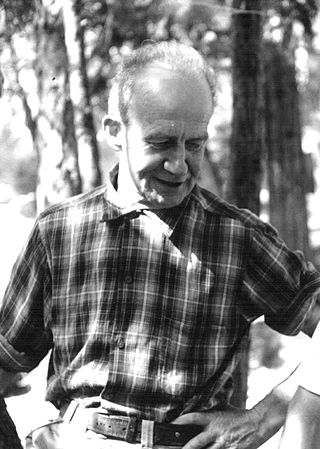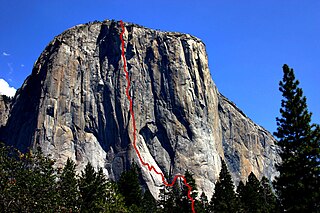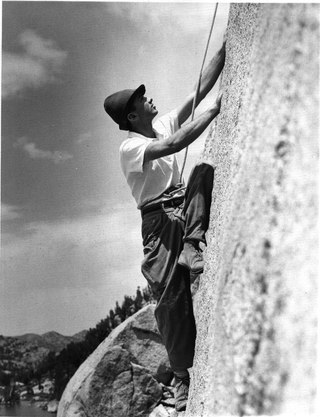
Half Dome is a quartz monzonite batholith at the eastern end of Yosemite Valley in Yosemite National Park, California. It is a well-known rock formation in the park, named for its distinct shape. One side is a sheer face while the other three sides are smooth and round, making it appear like a dome cut in half. It stands at nearly 8,800 feet above sea level and is composed of quartz monzonite, an igneous rock that solidified several thousand feet within the Earth. At its core are the remains of a magma chamber that cooled slowly and crystallized beneath the Earth's surface. The solidified magma chamber was then exposed and cut in half by erosion, therefore leading to the geographic name Half Dome.

El Capitan is a vertical rock formation in Yosemite National Park, on the north side of Yosemite Valley, near its western end. The granite monolith is about 3,000 feet (914 m) from base to summit along its tallest face and is a world-famous location for big wall climbing, including the disciplines of aid climbing, free climbing, and more recently for free solo climbing.

A piton in big wall climbing and in aid climbing is a metal spike that is driven into a crack or seam in the climbing surface using a climbing hammer, and which acts as an anchor for protecting the climber from falling or to assist progress in aid climbing. Pitons are equipped with an eye hole or a ring to which a carabiner is attached; the carabiner can then be directly or indirectly connected to a climbing rope.
Steve Roper is a noted climber and historian of the Sierra Nevada in the United States. He along with Allen Steck are the founding editors of the Sierra Club journal Ascent.

Slacklining is walking, running or balancing along a suspended length of flat webbing that is tensioned between two anchors. Slacklining is similar to slack rope walking and tightrope walking. Slacklines differ from tightwires and tightropes in the type of material used and the amount of tension applied during use. Slacklines are tensioned significantly less than tightropes or tightwires in order to create a dynamic line which will stretch and bounce like a long and narrow trampoline. Tension can be adjusted to suit the user, and different webbing may be used in various circumstances.

Warren Harding was one of the most accomplished and influential American big wall climbers and aid climbers of the 1950s to 1970s. He was the leader of the first team to climb El Capitan, Yosemite Valley, in 1958. The route they climbed, known as The Nose, ascends 2,900 feet (880 m) up the central buttress of what is one of the largest granite monoliths in the world. Harding made many first ascents in Yosemite, some 28 in all, including The Wall of Early Morning Light.

The Regular Northwest Face of Half Dome was the first Grade VI big wall climbing route in the United States. It was first climbed in 1957 by a team consisting of Royal Robbins, Mike Sherrick, and Jerry Gallwas. Its current aid climbing rating is VI 5.9 A1 or 5.12 for the free climbing variation. It is recognized in the historic climbing text Fifty Classic Climbs of North America and considered a classic around the world.

John Salathé was a Swiss-born American pioneering rock climber, blacksmith, and the inventor of the modern steel piton. In his later years he promoted Christian spiritualism and vegetarianism.

Fifty Classic Climbs of North America is a 1979 climbing guidebook and history written by Steve Roper and Allen Steck. It is considered a classic piece of climbing literature, known to many climbers as simply "The Book", and has served as an inspiration for more recent climbing books, such as Mark Kroese's Fifty Favorite Climbs. Though much of the book's contents are now out of date, it is still recognized as a definitive text which goes beyond the traditional guidebook.

The Nose is a big wall climbing route up El Capitan. Once considered impossible to climb, El Capitan is now the standard for big wall climbing. It is recognized in the historic climbing text Fifty Classic Climbs of North America and considered a classic around the world.

Lover's Leap is a steep granite cliff band in El Dorado County, California, United States, a landmark which catches the eye as one travels by, and a popular destination for climbers. The origin of its name is unknown, but common to most Lover's Leaps, one version from local folklore says two Native Americans lovers leapt to their deaths from the summit.

The Salathé Wall is one of the original big wall climbing routes up El Capitan, a 3,000-foot (900 m) high granite monolith in Yosemite National Park. The Salathé Wall was named by Yvon Chouinard in honor of John Salathé, a pioneer of rock climbing in Yosemite. The route is recognized in the historic climbing text Fifty Classic Climbs of North America and is considered a classic around the world.

The East Face of Mount Whitney is a technical alpine rock climbing route and is featured in Fifty Classic Climbs of North America. Mount Whitney is the highest peak in the contiguous United States.

The Steck-Salathé Route is a big wall traditional climbing route up Sentinel Rock.

The Royal Arches Route is a big wall climbing route in California's Yosemite Valley on the Royal Arches wall. The route is recognized in the historic climbing text Fifty Classic Climbs of North America. The route was first climbed Oct. 1936 by Ken Adam, Morgan Harris, K. Kenneth Davis. The route is moderate in difficulty and is frequently climbed. The first 4 pitches are along a west-facing dihedral. At Pitch 5, the route turns north and ascends the main face along crack systems. Pitch 10 can be free climbed at 5.10b however, most climbers use a fixed rope to pendulum to a long ledge. At the end of Pitch 15, begins the bolted rappel route. It is 18 rappels to the Valley floor. Some climbers prefer to continue to "The Jungle" at the end of Pitch 16. Beyond The Jungle is a 5.4 slab and 4th Class scrambling to the Valley Rim. The descent is usually accomplished by traversing northeast to Washington Column and descending the exposed North Dome Gully.

Jules Marquard Eichorn was an American mountaineer, environmentalist, and music teacher.
Allen Parker Steck was an American mountaineer and rock climber.

Thomas "Tom" M. Frost was an American rock climber known for big wall climbing first ascents in Yosemite Valley. He was also a photographer and climbing equipment manufacturer. Frost was born in Hollywood, California, and died in Oakdale, California.

Charles Marshall Pratt was an American rock climber known for big wall climbing first ascents in Yosemite Valley. He was also a long-time climbing instructor and mountain guide with Exum Mountain Guides in the Grand Tetons.

Jerry Gallwas is an American rock climber active in the 1950s during the dawn of the Golden Age of Yosemite Rock Climbing. He achieved a number of pioneering first ascents including sandstone spires in the American Southwest, and the first ascent of the Northwest Face of Half Dome with Royal Robbins and Mike Sherrick in 1957. Gallwas made his own heat-treated chrome-molybdenum steel alloy pitons, which contributed to the success of the climb.




![Heinz Zak [de] slacklining the spire Heinz Zak, Highline, Lost Arrow, El Capitan,Yosemites, USA.jpg](http://upload.wikimedia.org/wikipedia/commons/thumb/e/ec/Heinz_Zak%2C_Highline%2C_Lost_Arrow%2C_El_Capitan%2CYosemites%2C_USA.jpg/130px-Heinz_Zak%2C_Highline%2C_Lost_Arrow%2C_El_Capitan%2CYosemites%2C_USA.jpg)


















